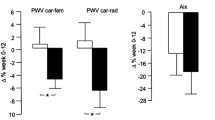Summary
The inflammatory effects of enalaprilat and cilazaprilat were tested in an experimental model of ovalbumin-sensitised guinea-pigs.
Enalaprilat, but not cilazaprilat, enhanced the ovalbumin-induced inflammatory skin responses. The effect of enalaprilat was dose-dependent. Enalaprilat significantly increased the skin content of substance P and histamine. Cilazaprilat did not alter the level of these inflammatory mediators.
Enalaprilat, applied locally, but not cilazaprilat, enhanced the inflammatory reactions caused by intradermal injections of allergen and substance P. Both angiotensin converting enzyme (ACE) inhibitors enhanced the inflammatory skin response evoked by bradykinin.
Our study strongly indicates that enalaprilat has pro-inflammatory properties, whereas the new long-acting ACE inhibitor cilazaprilat does not. This might give a better safety profile of cilazaprilat.
Similar content being viewed by others
References
Andersson RGG, Karlberg BE, Lindgren BR. Cough and other bronchial symptoms and skin disorders during treatment with ACE inhibitors. Läkartidningen 84: 183–184, 1987
Boulet LP, Cartier A, Thompson NC, Robert RS, Dolovich J, et al. Asthma and increases in nonallergic bronchial responsiveness from seasonal pollen exposure. Journal of Allergy and Clinical Immunology 71: 399–406, 1983
Casciere MA, Bull HG, Mumford RA, Patchett AA, Thornberry NA, et al. Carboxy-terminal tripetidyl hydrolysis of substance P by purified rabbit lung angiotensin converting enzyme and the potentiation of substance P activity in vivo by captopril and MK 422. Molecular Pharmacology 25: 287–293, 1983
Chalmers D, Dombey SL, Lawson DH. Marketing surveillance of captopril (for hypertension): a preliminary report. British Journal of Clinical Pharmacology 24: 343–349, 1987
Couture R, Regoli D. Inactivation of substance P and its C-terminal fragments in rat plasma and its inhibition by captopril. Canadian Journal of Physiology and Pharmacology 59: 621–624, 1981
Edwards IR, Coulter DM, Beasley DMG, McIntosh D. Captopril: four years of post-marketing surveillance of all patients in New Zealand. British Journal of Clinical Pharmacology 23: 529–536, 1987
Ferguson RK, Brunner HR, Turini GA, Gavras H, McKinstry DN. A specific orally active inhibitor of angiotensin-converting enzyme in man. Lancet 1: 775–778, 1977
Ferguson RK, Vlasses PH, Rothmensch HH. Clinical applications of the angiotensin converting enzyme inhibitors. American Journal of Medicine 77: 690–698, 1984
Ferreira SH. A bradykinin-potentiating factor (BPF) present in the venom of Bothrops jararaca. British Journal of Pharmacology and Chemotherapy 24: 163–169, 1965
Fügner A. Pharmacological aspects of immediate hypersensitivity reactions in vivo. In Devlin JP (Ed.) Pulmonary and antiallergic drugs, pp. 123–190, Wiley, New York, 1985
Fuller RW, Warren JB, McCusker, Dollery CT. Effect of enalapril on the skin response to bradykinin in man. British Journal of Clinical Pharmacology 23: 88–90, 1987
Fyhrquist F. Clinical pharmacology of the ACE inhibitors. Drugs 32 (Suppl. 5): 33–39, 1986
Joint National Committee. The 1988 report of the joint national committee on detection, evaluation and treatment of high blood pressure. Archives of Internal Medicine 148: 1023–1038, 1988
Lindgren BR, Andersson CD, Andersson RGG. Potentiation of inflammatory reactions in guinea-pig skin by an angiotensin converting enzyme inhibitor (MK 422). European Journal of Pharmacology 135: 383–387, 1987
Lindgren BR, Persson K, Kihlström JE, Andersson RGG. ACE-inhibitor induced enhancement of spontaneous and IgE-mediated histamine release from mast cells and basophilic leucocytes and the modulatory effect of capsaicin sensitive nerves. Pharmacology and Toxicology 64: 159–164, 1989a
Lindgren BR, Rosenqvist U, Ekström T, Grönneberg R, Karlberg BE, et al. Increased bronchial reactivity and potentiated anti-IgE-induced skin responses in hypertensive subjects suffering from coughs during angiotensin converting enzyme inhibitor therapy. Chest 95: 1225–1230, 1989b
Lowry OH, Rosebrough NJ, Farr AL, Randall RJ. Protein measurement with the phenol reagent. Journal of Biological Chemistry 193: 265–275, 1951
Ondetti MA, Rubin B, Chusman DW, Cheung HS, Sabo FF. Design of specific inhibitors of angiotensin converting enzyme: new class of orally active antihypertensive agents. Science 196: 441–444, 1977
Skidgel RA, Engelbrecht S, Johnson AR, Erdös EG. Hydrolysis of substance P and neurotensin by converting enzyme and neutral endopeptidase. Peptides 5: 769–776, 1984
Suarez M, Ho PW, Johnson ES, Perez G. Angioneurotic edema, agranulocytosis, and fatal septicemia following captopril therapy. American Journal of Medicine 336–338, 1986
Town GI, Hallwright GP, Maling T, O’Donnel TV. Angiotensin converting enzyme inhibitors and cough. New Zealand Medical Journal 100: 161–163, 1987
Wilkin JK, Hammon JJ, Kirkendall WM. The captopril-induced eruption. Archives of Dermatological Research 116: 902–905, 1980
World Health Organization International Society of Hypertension (WHO/ISH). Guidelines for the management of mild hypertension. Memorandum from WHO/ISH Meeting, 5th Mild Hypertension Conference 1989. Journal of Hypertension 7: 689–693, 1989
Wood SM, Mann RD. Angio-oedema and urticaria associated with angiotensin converting enzyme inhibitors. British Medical Journal 294: 91–92, 1987
Author information
Authors and Affiliations
Rights and permissions
About this article
Cite this article
Andersson, R.G.G., Karlberg, B.E., Lindgren, B.R. et al. Enalaprilat, but not Cilazaprilat, Increases Inflammatory Skin Reactions in Guinea-Pigs. Drugs 41 (Suppl 1), 48–53 (1991). https://doi.org/10.2165/00003495-199100411-00009
Published:
Issue Date:
DOI: https://doi.org/10.2165/00003495-199100411-00009




